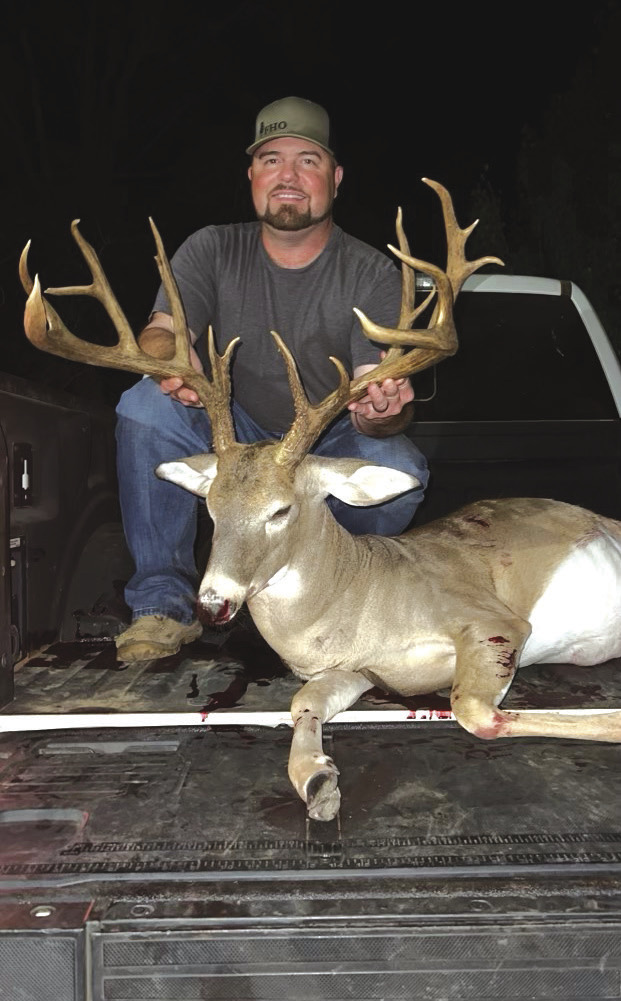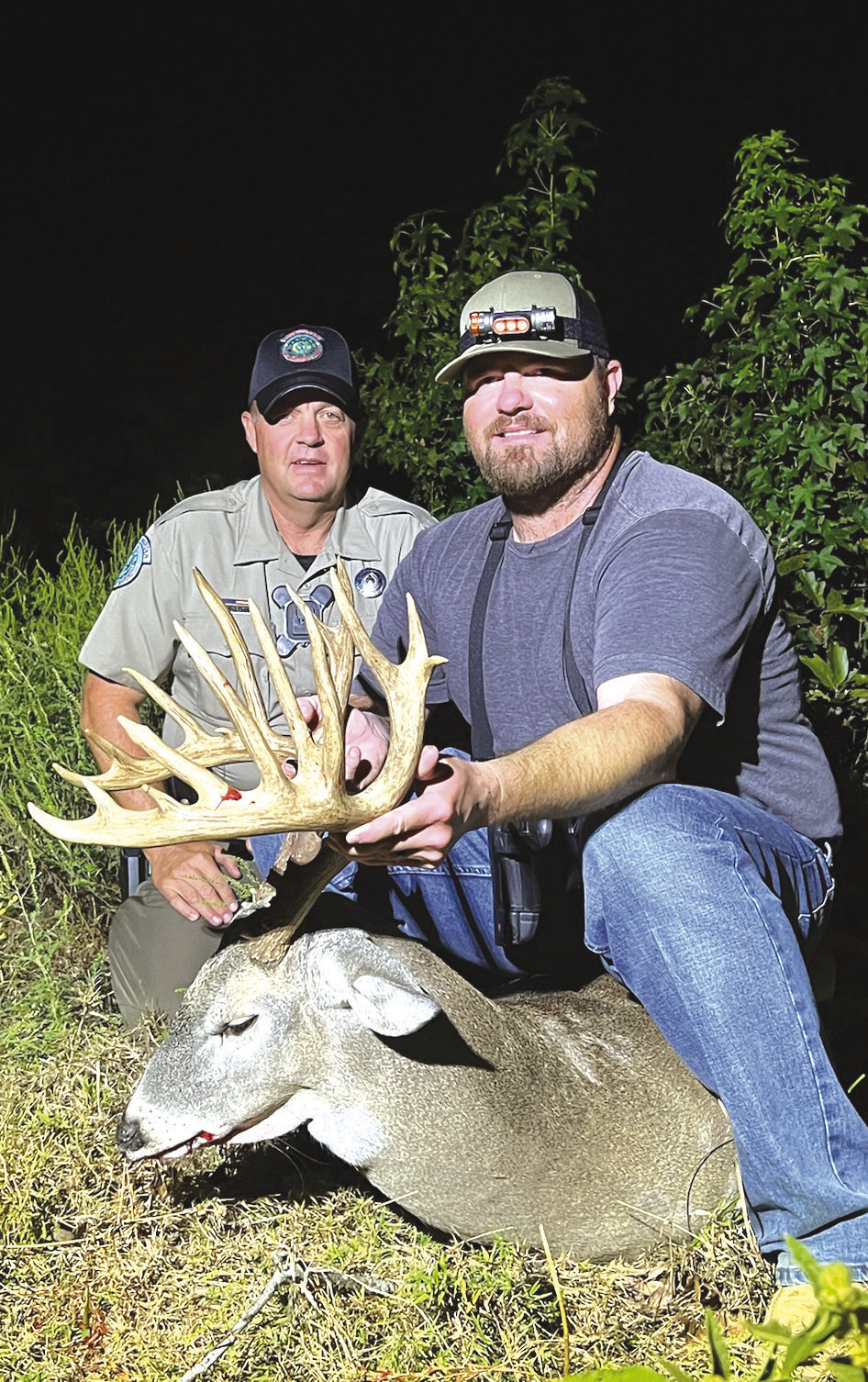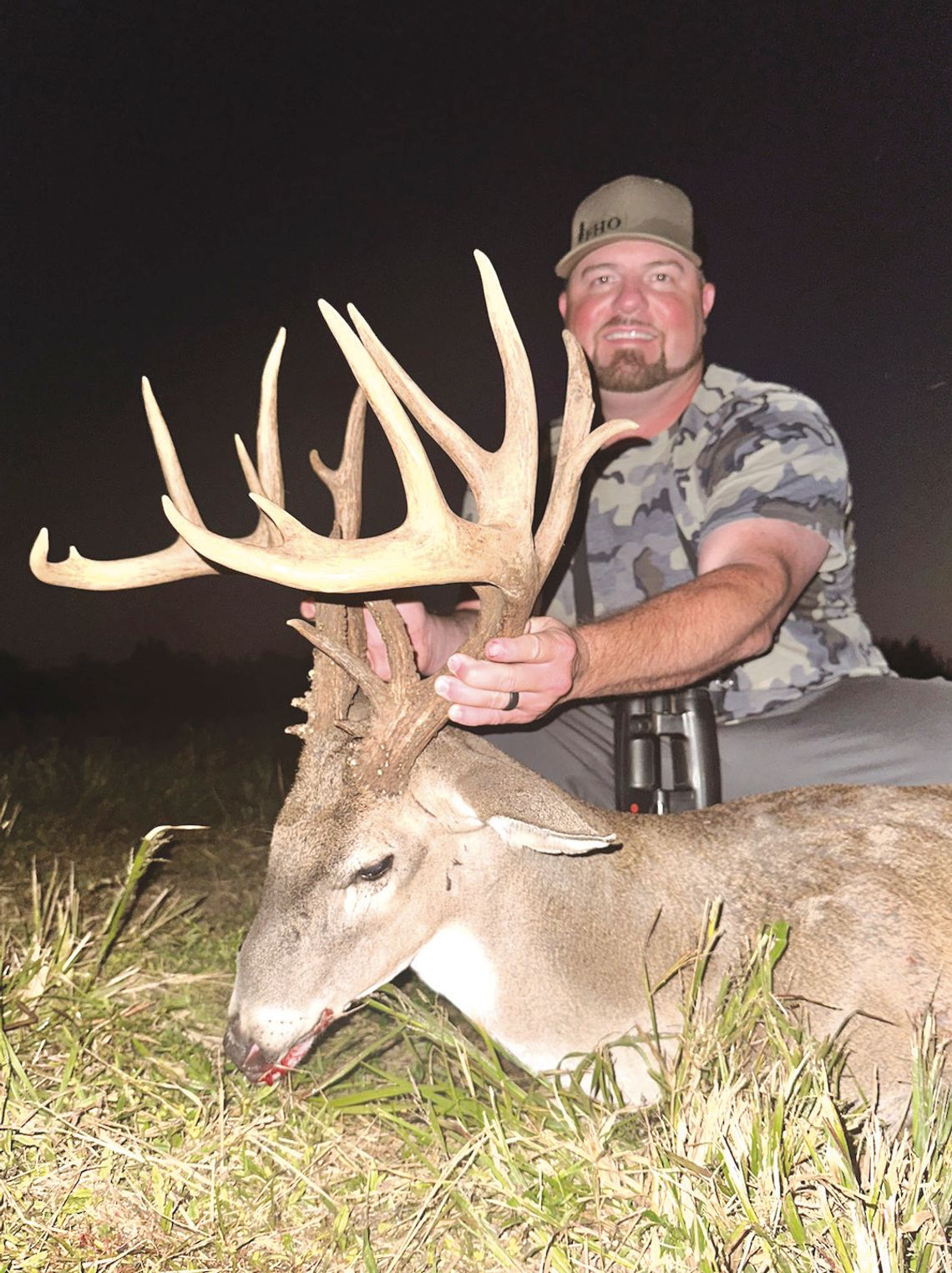Deer manager says letting the young guys walk to 7 1/2 is the key component to producing big bucks
Just when Forrest Hodges thought his deer season couldn’t get any better, it did.
On September 28 — opening day of the current statewide Managed Lands Deer and Archery Only whitetail seasons — the 37-year-old logging contractor from Jacksonville brought down a free-ranging whitetail buck with a magnificent set of antlers. Sporting 20 scorable points with thick main beams, the buck ran up a Boone and Crockett score of 187 4/8 inches. It weighed 220 pounds.
Amazingly, Hodges tagged two more mature bucks over the following three days that were equally impressive. Among them were a 195-pound 16 pointer scoring 188 2/8 B&C and a 219 pound 19 pointer taped at 178 6/8.
All three were taken off a pair of 4,000-acre tracts Hodges owns and manages in Cherokee County. Each buck was 7 1/2 years old.
Hodges said there were no tall fences or breeder deer involved. Just good ol’ free ranging whitetails allowed to grow old and fat on really good diets.
Pinch me if you think I’m dreaming, but I’ll assure you I’m not.
Hodges is the real deal, and the three bucks he shot using MLD permits issued by the Texas Parks and Wildlife Department are the byproducts of years of sacrifice, dedication and an unwavering faith in a philosophy that serious whitetail managers everywhere have been preaching for years: Age equals antler. “I’m a firm believer in it,” Hodges said. “There are several things you can do to help produce big deer, but age is definitely number one. A buck will never be able grow its best antlers if he gets shot when he’s young.”
Take that as sound advice from someone who knows. Hodges is a lifelong deer hunter who became intrigued with deer management and large antlers years ago when he spent several seasons hunting on the Callaghan Ranch in deep South Texas.
The 90,000-acre low fence ranch is located in Webb County, one of five South Texas counties that encompass what is known as the “golden triangle” of Texas deer hunting. It’s an area where landholdings are vast and the rich, red soil grows a wealth of natural forage packed with all sorts of nutritional goodies to make antler growth spike, especially in years with sufficient rainfall.
Land managers there have found a lucrative cash cow in managing their property for big bucks, and they have learned that allowing the animals to age to maturity is a key component in getting them there.
Hodges believes the same approach can be applied with success elsewhere. Even in areas of the state where larger properties are continually being splintered into smaller and smaller parcels.
“It’s harder to do in areas where the land is becoming more and more fragmented, but it can be done if hunters will come together and work towards the same thing,” Hodges said. “I know it will work because I’ve seen it happen.”
Building the Foundation
Hodges began managing his properties roughly six years ago under strict guidelines aimed at grooming his deer herds to be the best they can possibly be.
The effort started with restricting annual buck harvest to just a handful of deer a year to help build the age structure. He also implemented an intensive year-round feeding program to keep the deer fat and sassy, while bolstering antler growth on bucks from start to finish.
The feeding regime is overseen by Hodges’ father- in-law, Johnny Montgomery. The program includes planting more than 100 acres of year-round food plots to provide deer with a bounty of nutritious forage to supplement natural browse.
During spring and summer, Montgomery says he plants about 75 to 100 acres with a combination of cow peas, Sunn Hemp and Alice clover. He plants about 125 acres in fall and winter. The cool season plots are comprised of oats, wheat, rye grass, three varieties of clover and wildlife mix, Montgomery said.
Protein: Sold on Double Down
Protein and corn feeders are another key component of Hodges management program. Montgomery says he keeps multiple feeders filled with Double Down Custom Blend 20 percent all year long. The pelleted deer feed is high in protein that helps the deer stay fat, recover quickly after the rut and optimizes antler growth during spring and summer.
The feeding stations are closely monitored by game cameras. This allows for keeping close tabs on the quality of the deer utilizing them, and how frequently they are showing up. The cameras also help Hodges determine how individual deer progress from one year to the next and which ones he believes should be taken out of the herd.
“They absolutely love the Double Down,” Montgomery said. “I never let the protein feeders go dry. The protein feed, along with the food plots, really keeps the deer in good shape. Those big bucks Forrest shot were just layered in fat.”
Hodges said he experimented with several different protein brands before determining that Double Down seemed to benefit his deer herd the most. He says the animals developed a craving for the feed in short order. The results as the deer have aged have been more than convincing.
“When we first started feeding and planting food plots in 2020-21, we didn’t have a deer over 130 inches,” Hodges said. “It wasn’t long before we started seeing deer with bigger bodies and much heavier antlers with stickers and kickers — I was like holy moly!”
Today, Hodges says about 30 percent of the bucks in his herd will measure 150 inches or more at 6-1/2 years old. The average weight on those deer is over 200 pounds.
Age = Antler
Hodges pointed out that much of the success would not have been possible without allowing the bucks to age to maturity and beyond. He is way more selective than most when it comes to deciding which deer should be harvested. In his book, the target age is 7 1/2. He also likes to maintain a doe/ buck ratio around 2.5:1.
“Not many people believe in managing deer until they are 7 1/2,” Hodges said. “But I’ve seen what can happen when you do. I won’t shoot a buck until he is 5 1/2 years old, regardless of what he is. If he’s got any kind of frame at all I’ll let him go to see what happens. It will surprise you sometimes. If you want meat, shoot a doe.”
Hodges believes one of the biggest mistakes a deer manager can make is shooting a 5 1/2-year old 8 pointer based on the belief that it will always be an eight pointer.
“I’ve seen these older eight pointers turn into 10s, especially once we started putting the feed to them,” he said.
Hodges also thinks it is a bad idea to shoot a 5 1/2-year-old buck just because it starts showing signs of going downhill. He believes bucks are super dominant at that age, and the stress of the rut eventually catches up to them.
“They get run down so bad during the rut that they just aren’t able to put on as much horn the following year, because their bodies have to recover first come first,” he said. “But as a buck gets older he becomes more like an older man. He becomes less interested in fighting and chasing women. Instead, he just sits around and gets fat. When it’s antler growing season, he immediately starts growing antlers. In my opinion that’s when a lot of them really blow up. I’ve seen it happen more than once.”
More is Better
Hodges believes more is always better when managing for big bucks. The more older age class bucks you have in a herd, the better the chance there is of one of them blowing up into something really special.
“I’ve noticed that about 20 percent of bucks will blow up once they reach 7 1/2 and 8 1/2 years old,” he said. “If you’ve got 10 bucks that are 7 1/2 to 8 1/2, you’ve got a chance of two of them blowing up. If you’ve got 20, there’s a chance four of them could blow up. It’s taken some sacrifice to get where we are today with our program, but it’s worth it.”
Two of the bucks Hodges shot this year were late bloomers. He says the 178 6/8 inch 19 pointer was a 135 inch deer with 13 points last year. The 188 2/8 inch 16 pointer scored in the low 140s as a 10 pointer last season.
“Both of those deer blew up more than 40 inches this season,” he said. “That just shows what one more year of age can do.”










